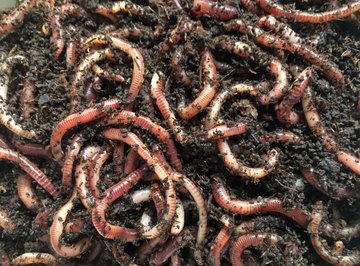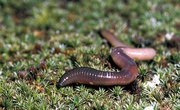
Earthworms play a vital role in the ecosystem by aerating the soil and allowing air and water to circulate. Without earthworms, countless microorganisms in the soil would be unable to survive, and the roots of plants would wither for lack of water and oxygen. But how do worms plow their soft little bodies through heavy, compacted earth?
Although worms may appear to be very simple creatures, they are actually complex and highly evolved--and perfectly suited for their ecological niche. Earthworms have a sleek, streamlined body and a hydrostatic, or fluid-based, skeleton, that allows them to change their shape and squeeze themselves into very tight crevices. Hydrostatic skeletons are also found in other soft-bodied animals such as mollusks and nematodes. In earthworms, the skeleton consists of pressurized fluid within a cavity in the body known as the coelom. The coelom extends throughout the body and is separated into many segments. Although the segments are interconnected, the worm is able to move them independently.
Surrounding the fluid-filled coelom are two sets of muscles. Circular muscles wrap around each segment, and longitudinal muscles extend across the length of the body. These muscles are powerful and well-developed. The circular and longitudinal muscles work together to help the earthworm writhe, wiggle and push its way through the substratum of soil.
Worms are also covered in short, bristly hairs called setae. While they are nearly invisible to the naked eye, you should be able to feel them if you try petting a worm the "right" and "wrong" way. You can also observe the setae by placing a clean worm on a slightly rough surface, such as a paper towel. If you listen carefully, you should be able to hear the setae scraping against the paper as the worm moves. The setae are normally held inside the earthworm's body, but they are extended when the worm is burrowing or anchoring itself in the soil. When a bird or other animal tries to pull an earthworm up from the dirt, the setae hold the worm in place, and they are so strong that the worm's body might snap in two before the setae lose their grip.
To burrow through the earth, a worm will flex its circular and longitudinal muscles to make itself long, then will extend the setae on its anterior, or front end to anchor itself in the earth. It will then contract its muscles to make its body short and bring the posterior, or back end, closer to the front. The worm will then extend the setae on its posterior end to anchor it in place, and then will extend its muscles to make itself long and push its anterior through the earth. It will repeat this process again and again. Earthworms are able to control the muscles and setae on each segment individually to aid in complex locomotion.
About the Author
Heidi Almond worked in the natural foods industry for more than seven years before becoming a full-time freelancer in 2010. She has been published in "Mother Earth News," "Legacy" magazine and in several local publications in Duluth, Minn. In 2002 Almond graduated cum laude from an environmental liberal arts college with a concentration in writing.
